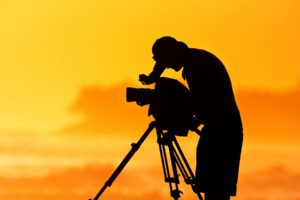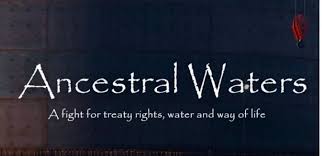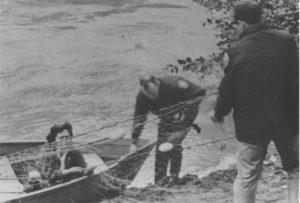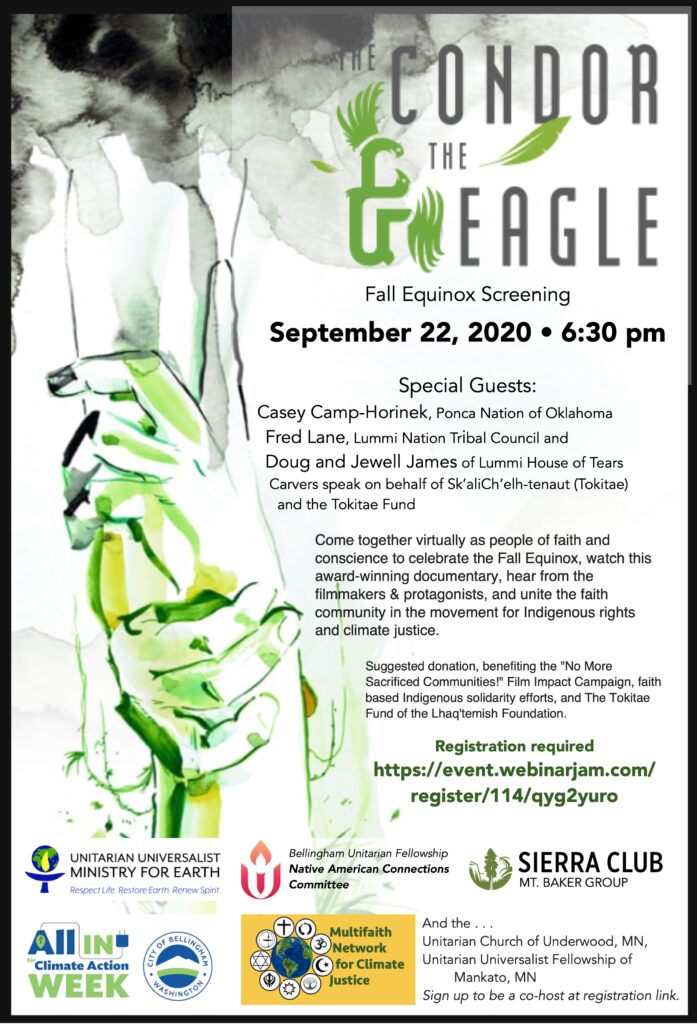
Below are recommended films and videos that will hopefully increase awareness of the uniqueness of Indian Country.
You are encouraged to make your own recommendations to be added to this listing. Recommendations should be sent to dwcruz@comcast.net.
Please include full film/title name, a brief description of what the film is about and some comments on how the film made an impact on you or your audience.
In the meantime, check out our feature film, some of the film resource sites below as well as the recommended films.
Feature Films
 “Ancestral Waters” is the story of the Puyallup Tribes fight for their treaty, their water, and their way of life. For 164 years, since the signing of the Medicine Creek Treaty, they have had to fight for the guarantees implicit in their treaty. The film follows tribal members as they work to stop the dangerous fracked gas processing facility, Tacoma LNG plan, on protected treaty territory. Produced by the Native Daily Network, 2019.
“Ancestral Waters” is the story of the Puyallup Tribes fight for their treaty, their water, and their way of life. For 164 years, since the signing of the Medicine Creek Treaty, they have had to fight for the guarantees implicit in their treaty. The film follows tribal members as they work to stop the dangerous fracked gas processing facility, Tacoma LNG plan, on protected treaty territory. Produced by the Native Daily Network, 2019.
 “As Long As Rivers Run” tells the story of the struggles of the Nisqually Tribe, and of Billy Frank, Jr., in particular, who led in the defense of the tribe’s fishing rights that were established by treaty in 1854 but denied. This tale of persistent personal and tribal bravery in the face of government brutality culminated in the Bolt Decision of 1974. The decision confirmed the Treaty provision that First American Indian Nations in Washington have claim to 50% of the salmon take in Washington State each year. Consequently, they must have an equal voice in salmon sustainability planning. The Nisqually Tribe’s efforts to preserve salmon spawning streams and surrounding natural habitats, through advocacy of environmental protection policies are enhanced by the work of the non-profit organization, Salmon Defense.
“As Long As Rivers Run” tells the story of the struggles of the Nisqually Tribe, and of Billy Frank, Jr., in particular, who led in the defense of the tribe’s fishing rights that were established by treaty in 1854 but denied. This tale of persistent personal and tribal bravery in the face of government brutality culminated in the Bolt Decision of 1974. The decision confirmed the Treaty provision that First American Indian Nations in Washington have claim to 50% of the salmon take in Washington State each year. Consequently, they must have an equal voice in salmon sustainability planning. The Nisqually Tribe’s efforts to preserve salmon spawning streams and surrounding natural habitats, through advocacy of environmental protection policies are enhanced by the work of the non-profit organization, Salmon Defense.
“Dawnland” is selected for its importance in being used an example of the currently building Truth and Reconciliation movement here in Washington State.
“For most of the 20th century, government agents systematically forced Native American children from their homes and placed them with white families. As recently as the 1970’s, one in four Native children nationwide were living in non-Native foster care, adoptive homes, or boarding schools. Many children experienced devastating emotional and physical harm by adults who mistreated them and tried to erase their cultural identity.
Now, for the first time, they are being asked to share their stories . . . In Maine, a historic investigation—the first government-sanctioned truth and reconciliation commission (TRC) in the United States—begins a bold journey. ” Read more here.
FAIN: Indigenous Film and Video Resources
Below is a list of recommended individual films. Keep a look out for area film festivals and Native/American Indian film festivals as well, especially Red Nation Film Festival.
Blood Memory: For Sandy White Hawk, the story of America’s Indian Adoption Era is not one of saving children but of destroying tribes and families. At 18 months, Sandy was removed from her Sicangu Lakota relatives and taken to live with a Christian missionary couple 400 miles away, where her skin color and cultural heritage were rejected. She grew up void of kinship and familial support, feeling ugly, alone and unworthy of love. Her adoption, which she later found to be part of a nationwide assimilative movement that targeted American Indian children, defined her and took much of her adult life to overcome. Reconnection with her Lakota community empowered Sandy to help other Adoption Era survivors restore their cultural identity through song and ceremony.
Cherokee Word for Water: The Cherokee Word for Water is based on the true story of the Bell Waterline Project. The feature film is set in the early 1980s in a rural Oklahoma Cherokee community where many houses lacked running water. Led by Wilma Mankiller (played by Kimberly Guerrero, A&E’s Longmire) and Cherokee organizer Charlie Soap (played by Mo Brings Plenty, Netflix’s House of Cards), the community of volunteers built nearly 20 miles of waterline to save their community. The successful completion of the waterline, using the traditional concept of gadugi — working together to solve a problem – led to Wilma’s election as Chief, Wilma and Charlie’s marriage and sparked a movement of similar self-help projects across the Cherokee Nation and in Indian Country that continues to this day.
Indian Horse: Saul’s talent leads him away from the misery of the school, eventually leading him to the Pros. But the ghosts of Saul’s past are always present, and threaten to derail his promising career and future. Forced to confront his painful past, Saul draws on the spirit of his ancestors and the understanding of his friends to begin the process of healing. (Deb’s Note: This film is highly controversial because of the lead actor’s alleged history of domestic violence).
We Shall Remain: PBS series covering some of America’s tragic history with her Indigenous peoples. Episodes include “After the Mayflower,” “Tecumseh’s Vision,” “Trail of Tears,” “Geronimo,” and “Wounded Knee.”
“As Long As Rivers Run” tells the story of the struggles of the Nisqually Tribe, and of Billy Frank, Jr., in particular, who led in the defense of the tribe’s fishing rights that were established by treaty in 1854 but denied. This tale of persistent personal and tribal bravery in the face of government brutality culminated in the Bolt Decision of 1974. The decision confirmed the Treaty provision that First American Indian Nations in Washington have claim to 50% of the salmon take in Washington State each year. Consequently, they must have an equal voice in salmon sustainability planning. The Nisqually Tribe’s efforts to preserve salmon spawning streams and surrounding natural habitats, through advocacy of environmental protection policies are enhanced by the work of the non-profit organization, Salmon Defense.
Back to the River: From our collection of extensive interviews with the people involved in the Fishing Wars plus added interviews, we compiled an hour-long video called “Back to the River.” It is designated as a companion video to “As Long as the Rivers Run” to help today’s viewers understand the struggle for recognition of tribal treaty fishing rights and to share the experience through their eyes. The film bridges the gap of misunderstanding by educating the public about this vital time period that shaped Pacific Northwest history and helped open doors to many tribes throughout the United States.
The Doctrine of Discovery: Unmasking The Domination Code: “The Doctrine of Discovery unmasking The Domination Code ” created by filmmaker Sheldon Wolfchild. This film focuses on a little known subject traced back to Christopher Columbus’s so-called “discovery” of the lands now commonly known as “the Americas.” The “right of discovery” was adopted and used by the U.S. Supreme Court in 1823 in the case Johnson & Graham’s Lessee v. M’Intosh. The first Christian people to discover lands inhabited by non-Christians or “heathens” had asserted the “ultimate dominion” to be in themselves. On the basis of that religiously premised argument, the Supreme Court defined the land title of the Indians as a “mere right of occupancy.” The Christian power that claimed “ultimate dominion” could grant away the soil while yet in the possession of “heathens.” And this doctrine remains the Supreme Law of the Land in the United States.
Promised Land: Promised Land is an award-winning social justice documentary that follows two tribes in the Pacific Northwest: the Duwamish and the Chinook, as they fight for the restoration of treaty rights they’ve long been denied. In following their story, the film examines a larger problem in the way that the government and society still looks at tribal sovereignty.
Neither Wolf Nor Dog: Based on Kent Nerburn’s 1996 bestselling novel of the same name, Neither Wolf Nor Dog is the story of a well-meaning white writer (Nerburn himself, played by Christopher Sweeney) who is drawn into Native culture when a Lakota elder asks him to turn a box full of notes into a book. The elder — a man named Dan is played by 95-year-old David Bald Eagle — uses the opportunity to poke holes in Nerburn’s — and the audience’s — assumptions about Native people.
March Point: Meet Cody, Nick and Travis—three teenagers from the Swinomish Tribe. After hard times on the rez lead to rehab and drug court, they are offered an alternative: to make a documentary about the impact of two oil refineries on their community. A collaborative coming of age story, MARCH POINT follows the ambivalent and once-troubled teens as they come to understand themselves and the threat their people face.
The Earth is Alive: The Earth is Alive is a 29-minute message from the Coast Salish People of the Salish Sea. As presented to the UN Global Conference on Climate Change in Paris, FR, the message includes testimony from: Eugene Harry (Malahat), Gwen Point (Sto:lo), Chief Tom Sampson (Tsartlip/Nez Perce), Jewell James (Lummi), Deborah Parker (Tulalip), Steven Point (Sto:lo) and traditional family songs by Shirley Bob & Family. © 2015 Setting Sun Productions • Darrell Hillaire (Lummi) Producer • Bob Ridgley – Director • Freddie Lane (Lummi) Co-Producer • www.settingsunproductions.org
100 Years: One Woman’s Fight for Justice: In 1996, Elouise Cobell, a Blackfeet Warrior, filed the largest class action lawsuit ever filed against the Federal Government. This is the story of how she prevailed and made history.
This Is Indian Country: THIS IS INDIAN COUNTRY is a multi‐platform series of specials and short films, following Willie Frank and the travels of his father to these spectacular and far‐flung locations, immersing in these cultures, witnessing stories and telling their own, and bringing to the non‐Native world a deeply honest and absolutely engaging experience with Indian Country.
Awake: A Dream from Standing Rock: “Awake: A Dream from Standing Rock” is more than a documentary; it is a jarring dream sequence, a cinematic poem of juxtaposed images and scenes of life and violence that defined the months-long Indigenous-led protest against the construction of the Dakota Access Pipeline (DAPL) north of the Standing Rock Indian Reservation.
Tribal Fishing 201: Pt. 1 Treaty fishermen use gillnets to selectively harvest salmon. Scott Schuyler, natural resources director for the Upper Skagit Tribe, explains how they work. Pt. 2 Lorraine Loomis, fisheries director for the Swinomish Indian Tribal Community, negotiates on behalf of treaty tribes to craft salmon fisheries with the state co-managers. Pt. 3 Shawn Yanity, Stillaguamish chairman and fisheries manager, is ensuring that fishing traditions are passed down to tribal youth, and hopes there will be fish left for them to harvest.
Condor and the Eagle: Four Indigenous environmental leaders embark on an extraordinary trans-continental adventure from the Boreal forest to deep into the heart of the Amazonian jungle to unite the peoples of North and South America and deepen the meaning of “Climate Justice”. The Condor & The Eagle documentary offers a glimpse into a developing spiritual renaissance as the film four protagonists learn from each other’s long legacy of resistance to colonialism and its extractive economy. Their path through the jungle takes them on an unexpectedly challenging and liberating journey, which will forever change their attachment to the Earth and one another.
Women of the White Buffalo: The Lakota women living on the Pine Ridge Indian Reservation in South Dakota are rising up against the forces that continue to suppress them. By preserving and protecting their ancestral values and wisdom, they provide a source of hope to their people. With exclusive access to the lives of 8 women, insight is gained into the experience of modern Indigenous American women living on a reservation.
Once Upon A River: Once Upon A River is the story of Native American teenager Margo Crane in 1970s rural Michigan. Margo, overcomes trauma with resilience and is forced to journey on the Stark River in search of her estranged mother. As Margo uses the skills she was taught by her father to survive, she meets many characters along the way. Most important among them is Smoke, and the two strike up an unlikely friendship. Despite the harsh conditions, caught beautifully on camera, Margo is able to stay true to herself as she discovers what it means to live.
Sacheen, Breaking the Silence: SACHEEN is a short documentary film that offers Sacheen Littlefeather, a 71-year-old White Mountain Apache and Yaqui elder, actress, activist, dancer, educator, and writer, living in Northern California, the opportunity to share her own story, in her own words, that has been waiting 45 years to be told. As we revisit one of the most memorable and controversial moments in the history of the Academy Awards, Sacheen’s voice will finally be joined together with today’s brave women, who are determined to make their voices heard around the world.
Three Feathers: During the course of a robbery, they cause great injury to a respected Elder. The community is enraged and demand justice, but the justice given is through a traditional sentencing circle. The youth are sent to live on the land for nine months with two Dene Elders. At first the young men rebel against the support of the Elders but, with the land as their teacher, they soon come to rely on the wisdom and guidance of the Elders.
Sovereignty, Climate Change & So Much More: Oren Lyons,Tom Sampson, Jeremiah “Jay” Julius, Jewel James, Tony Hillaire. Sovereignty, climate change, and indigenous relationship/history in regards to the US government’s formation are all part of this wonderful discussion.
Remove the Dams – Full Speech Chairman Jay Julius Stands with Yakama Nation: Lummi Chairman Jay Julius stands with Yakama Nation for the removal of the Columbia River Dams that reside in their territories. We choose Salmon!
Princess Angeline: Princess Angeline, daughter of Chief Seattle, is seen on many postcards and toward the end of her life, she lived alone, refusing to leave her homeland. What historical events led to her being one of the few Duwamish people left in Seattle by the 1890′s, only 35 years after the peace treaty? This video explores the story of the Duwamish and their unrecognized tribal status primarily through the life of Princess Angeline.
Other Video Resources include:
https://www.uumfe.org/resources/webinars/
Seaquarim's Shame: Episode 2 - Talequah
A mother orca grieves the death of her only minutes old baby in the Salish Sea in the summer of 2018. The world media becomes fixated. 4 years later she has a new baby boy, Phoenix. A landlocked girl from Ohio won’t let her dreams of the sea go unrealized. Be there as has her first encounter with an orca. Today she is an accomplished marine naturalist & creator & hosts one of the best podcasts on the Southern Residents: Breaching Extinction. A Vietnam war veteran discovers Indian Country, finding where things feel right, after years on a motorcycle discovering America. Meet an ally of The Lummi First nation who’s been witness & supporter in their fight to save the Qw'e lh'ol me chen.
Listen here.
Seaquarim's Shame: Episode 1 - Tokitae
Something is wrong at Miami Seaquarium.. They have been keeping an orca who doesn’t belong to them for over 50 years. A produce salesman turned vegan activist fights for over a decade on the street corner in front of Miami Seaquarium, turning away thousands of cars. A new legal fight launches in 2020 headed by The Lummi Nation of the Pacific North West. Still: 19,785 days later Lolita the whale remains alone in the smallest tank in the world. Episode 1: Tokitae
Listen here.
Finding Humanity Podcasts
 To unpack some of the biggest threats humanity is grappling with today, each episode will draw on the expertise and life experiences of members of The Elders: former Presidents and Prime Ministers, UN officials, Nobel Peace Laureates, freedom fighters, and human rights champions, brought together by Nelson Mandela in 2007. From leading nations out of conflict, to defending the human rights of the most vulnerable, this series will explore how we, through our shared humanity, bold advocacy, and collective action, can challenge injustice and promote ethical leadership.
To unpack some of the biggest threats humanity is grappling with today, each episode will draw on the expertise and life experiences of members of The Elders: former Presidents and Prime Ministers, UN officials, Nobel Peace Laureates, freedom fighters, and human rights champions, brought together by Nelson Mandela in 2007. From leading nations out of conflict, to defending the human rights of the most vulnerable, this series will explore how we, through our shared humanity, bold advocacy, and collective action, can challenge injustice and promote ethical leadership.
3 New Environmental Docs to Watch This Fall
Ecowatch Recommendations:
Kiss the Ground:
Between wildfires devastating the U.S. West Coast and storms battering the Gulf, the impacts of the climate crisis can feel overwhelming right now. Kiss the Ground offers an alternative to all of the bad news by focusing on solutions. The film, directed by Josh and Rebecca Tickell and narrated by Woody Harrelson, explains how we can heal the Earth through "regenerative agriculture," farming practices that draw carbon dioxide from the atmosphere and into soil as a way to restore soil health, which in turn boosts ecosystems and food supplies.Public Trust: The Fight for America's Public Lands
This award-winning documentary tells the stories of Indigenous activists, journalists, whistleblowers and historians working to protect America's public lands. The film focuses on three political struggles: the shrinking of Bears Ears National Monument in Utah, the mining of Boundary Waters Wilderness in Minnesota and the opening of the Arctic National Wildlife Refuge to fossil fuel exploration.David Attenborough: A Life on Our Planet
David Attenborough: A Life on Our Planet, which was also produced by Silverback Films and directed by Alastair Fothergill, Jonnie Hughes and Keith Scholey, features an intimate conversation between Attenborough and Sir Michael Palin as the broadcaster reflects on his life and a career that took him to every continent on Earth. In addition to streaming on Netflix, the movie will be available in select theaters starting Sept. 28. "For decades, David has brought the natural world to the homes of audiences worldwide, but there has never been a more significant moment for him to share his own story and reflections," WWF executive producer Colin Butfield said in a statement. "This film coincides with a monumental year for environmental action as world leaders make critical decisions on nature and climate. It sends a powerful message from the most inspiring and celebrated naturalist of our time." Read more here.
“The Condor and the Eagle” film screening and fundraiser for Tokitae Fund of Lummi Nation’s Lhaqtemish Foundation
The Indian System Film Screening
The Indian System
Sunday, June 21, 2020 / Time: 1:00 – 3:15 pm (Pacific time) Zoom film screening.
Dismantling the Doctrine of Discovery
DoD-Unmasking the Domination Code.5.3.20r1
7 of the Best New Documentaries About Global Warming
"Back to the River"
"Long as the River Runs" was a film that was offered at Justice Summit in October of 2019 by Salmon Defense (founded by Billy Frank, Jr.). There is now a companion film: From our collection of extensive interviews with the people involved in the Fishing Wars plus added interviews, we compiled an hour-long video called “Back to the River.” It is designated as a companion video to “As Long as the Rivers Run” to help today’s viewers understand the struggle for recognition of tribal treaty fishing rights and to share the experience through their eyes. The film bridges the gap of misunderstanding by educating the public about this vital time period that shaped Pacific Northwest history and helped open doors to many tribes throughout the United States. February 1, 2013 marked the release of “Back to the River” which premiered at the Seattle Aquarium. Guests received copies of “Back to the River” and “As Long as the Rivers Run.” From there we have continued a touring roll-out of “Back to the River” at different reservations. Back to the River tells the story of the treaty rights struggle from the pre-Boldt era to tribal and state co-management. The movie includes the voices and personal accounts of tribal fishers, leaders and others active in the treaty fishing rights struggle. You can now view “Back to the River” in its entirety online: Back to the River from Salmon Defense on Vimeo.
For the Wild - Radio interviews
For The Wild is an anthology of the Anthropocene; focused on land based protection, co-liberation and intersectional storytelling rooted in a paradigm shift from human supremacy towards deep ecology. This is a series of radio programs interviewing a number of activists and leaders on a variety of justice issues, most particular those of indigenous communities and the struggles to protect the Earth and its human and nature communities.
Crosscut Documentaries presents: The Rising
As Long as Rivers Run - Recommended Film - First American Indian Nations
As Long As Rivers Run tells the story of the struggles of the Nisqually Tribe, and of Billy Frank, Jr., in particular, who led in the defense of the tribe’s fishing rights that were established by treaty in 1854 but denied. This tale of persistent personal and tribal bravery in the face of government brutality culminated in the Bolt Decision of 1974. The decision confirmed the Treaty provision that First American Indian Nations in Washington have claim to 50% of the salmon take in Washington State each year. Consequently, they must have an equal voice in salmon sustainability planning. The Nisqually Tribe’s efforts to preserve salmon spawning streams and surrounding natural habitats, through advocacy of environmental protection policies are enhanced by the work of the non-profit organization, Salmon Defense.
Summit Pre-Event Film: "As Long As the Rivers Run" with Willie and Peggen Frank, Oct. 11, Olympia WA
SALMON PEOPLE & OTHER STORIES
Presented by Children of the Setting Sun Productions Sunday, October 13 at 2:45 A Pickdford Film Center offering Bellingham, WA a hosted presentation and discussion after the screening Children of the Setting Sun Productions returns after a full year of filming in and around the Salish Sea. Come see the vibrancy of local Native cultures in a series of short films, the latest honoring the Women of Canoe Journey in this year's Paddle to Lummi. Also showing is Salmon People, with new scenes illuminating the intricate relationship between salmon and the Coast Salish peoples.
